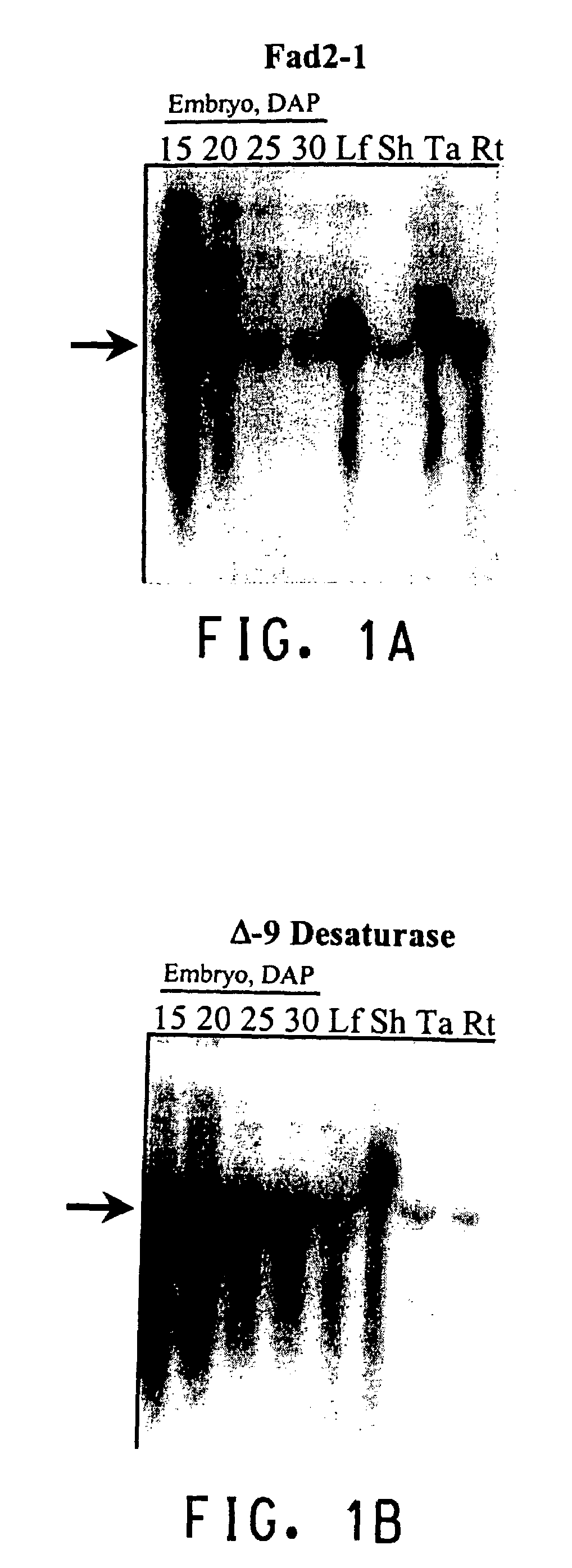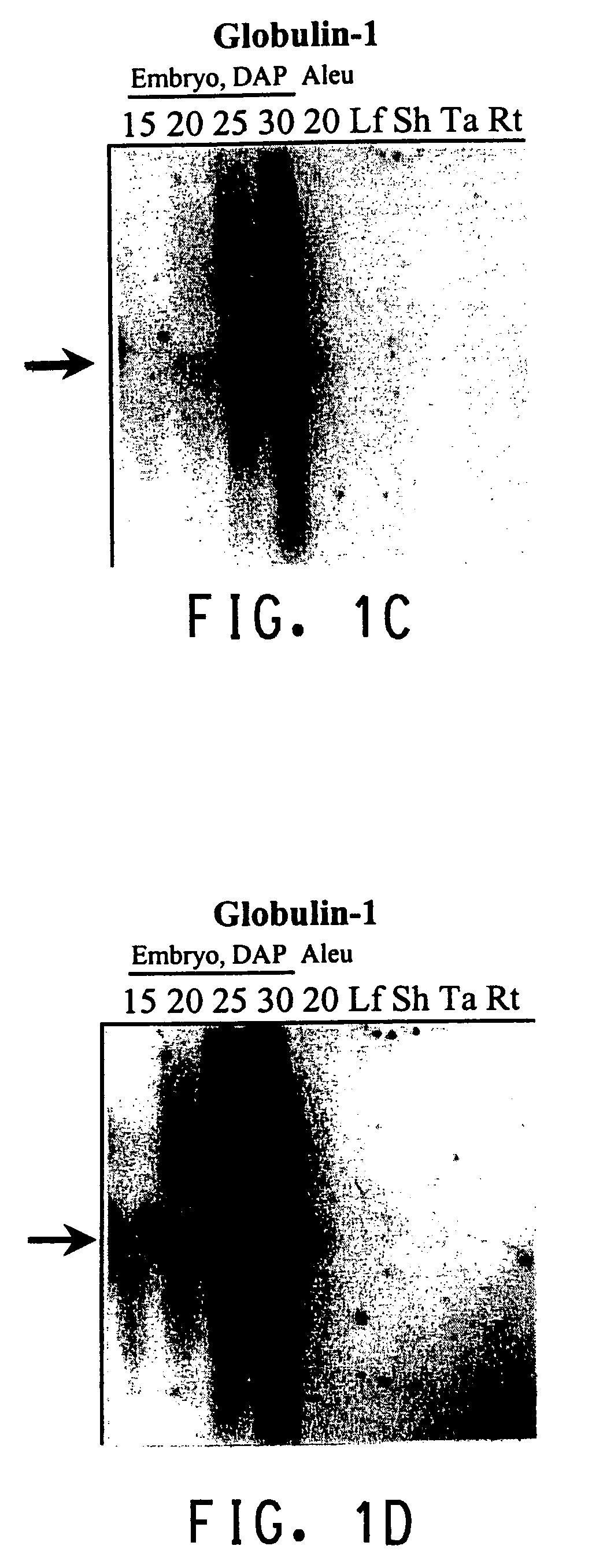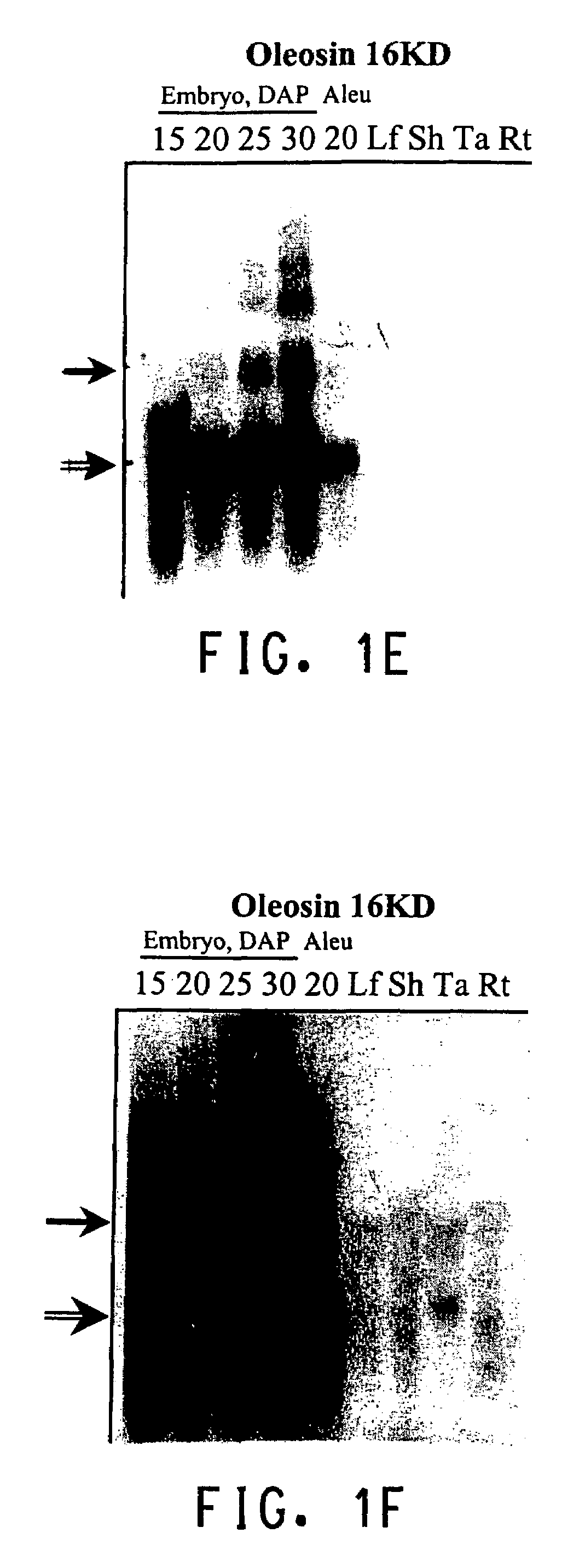Method for improving the carcass quality of an animal
a carcass quality and animal technology, applied in the direction of fatty-oil/fat refining, fatty acid chemical modification, fatty-oil/fat separation, etc., can solve the problems of unstable oil, prone to disagreeable odor and flavor, and reduce the number of polyunsaturated fats, etc., to achieve the effect of improving the carcass quality of the animal
- Summary
- Abstract
- Description
- Claims
- Application Information
AI Technical Summary
Benefits of technology
Problems solved by technology
Method used
Image
Examples
example 1
Corn fad2-2 cDNA and Genomic DNA Clones
[0176]A corn embryo cDNA library was screened using a radioisotopically-labeled DNA fragment obtained by PCR and containing the corn gene for delta-12 desaturase (“fad2-1”, WO 94 / 11516, and set forth in SEQ ID NO:1). A second delta-12 desaturase cDNA clone was identified on the basis of its sequence. The second gene for delta-12 desaturase is designated fad2-2.
[0177]The full-length cDNA sequence is shown in SEQ ID NO:2. It encodes a polypeptide of 392 amino acids (translation frame: nucleotide 176–1351). The coding region of the corn fad2-2 shares significant sequence identity with fad2-1: they share 88% identify at the amino acid level, and 92% at the nucleotide level. They also possess 77% identity at the 5′-untranslated region, and 64% at the 3′ end.
[0178]A full-length or a portion of the coding region of either one of genes in either antisense or sense approach may be used to suppress both the fad2-1 and fad2-2 genes or gene products, due t...
example 2
Corn fad2-1 Intron
[0180]Based on the fad2-2 intron sequence (SEQ ID NO:4), primers (SEQ ID NOS:54 and 55) were designed for PCR amplification of a fad2-2 fragment from corn genomic DNA for use in mapping the fad2-2 locus.
[0181]
5′-CTGCACTGAAAGTTTTGGCA-3′SEQ ID NO:545′-AGTACAGCGGCCAGGCGGCGTAGCG-3′SEQ ID NO:55
[0182]In addition to the expected 0.8 kb fragment that should result from amplification from the fad2-2 sequence, a second fragment, 1.1 kb in length, was also produced in the same PCR. The 1.1 kb fragment was purified, sequenced, and it was determined that this fragment contains a portion of the fad2-1 intron. A new set of primers (SEQ ID NOS:56 and 57) were designed according to the sequences of this 1.1 kb partial intron, and the 5′-untranslated region of fad2-1.
[0183]
5′-AAGGGGAGAGAGAGGTGAGG-3′SEQ ID NO:565′-TGCATTGAAGGTGGTGGTAA-3′SEQ ID NO:57
[0184]Using the new primer set and corn genomic DNA as the template, a PCR product containing the other half of the fad2-1 intron was obt...
example 3
[0188]Cloning and Sequencing of Corn Delta-9 Desaturase cDNA
[0189]Degenerate primers were designed according to the conserved regions of delta-9 desaturase genes from various species, and used for PCR. These are set forth in SEQ ID NOS:6 and 7.
[0190]
5′-GAYATGATHACNGARGAR-3′SEQ ID NO:65′-CCRTCRTACATNAGATG-3′SEQ ID NO:7
[0191]Two PCR fragments (520 and 500 bp, respectively) were generated when these oligomers were used as primers and DNA from a corn embryo cDNA library was used as a template. The fragments were purified and used as probes to screen a corn embryo cDNA library. Two independent clones (pCD520, and pCD500) were isolated.
[0192]These two clones were sequenced, and cross-hybridized between themselves and with the soybean delta-9 desaturase gene. It was confirmed that only the insert of pCD520 was homologous to the soybean delta-9 desaturase gene. The cDNA sequence was shown in SEQ ID NO:8. Nucleotide number 1–133 is the 5′-untranslated leader sequence. The coding sequence sta...
PUM
| Property | Measurement | Unit |
|---|---|---|
| Fraction | aaaaa | aaaaa |
| Fraction | aaaaa | aaaaa |
| Fraction | aaaaa | aaaaa |
Abstract
Description
Claims
Application Information
 Login to View More
Login to View More - R&D
- Intellectual Property
- Life Sciences
- Materials
- Tech Scout
- Unparalleled Data Quality
- Higher Quality Content
- 60% Fewer Hallucinations
Browse by: Latest US Patents, China's latest patents, Technical Efficacy Thesaurus, Application Domain, Technology Topic, Popular Technical Reports.
© 2025 PatSnap. All rights reserved.Legal|Privacy policy|Modern Slavery Act Transparency Statement|Sitemap|About US| Contact US: help@patsnap.com



